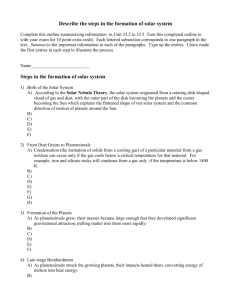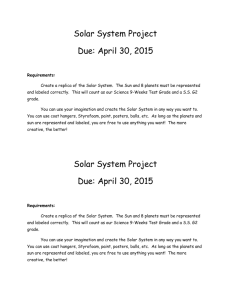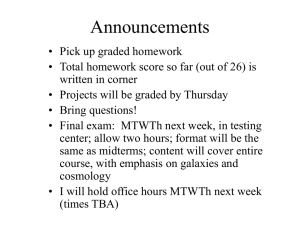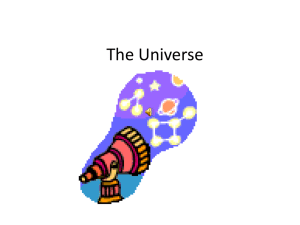Physics 202 Introduction to Astronomy and Cosmology
advertisement
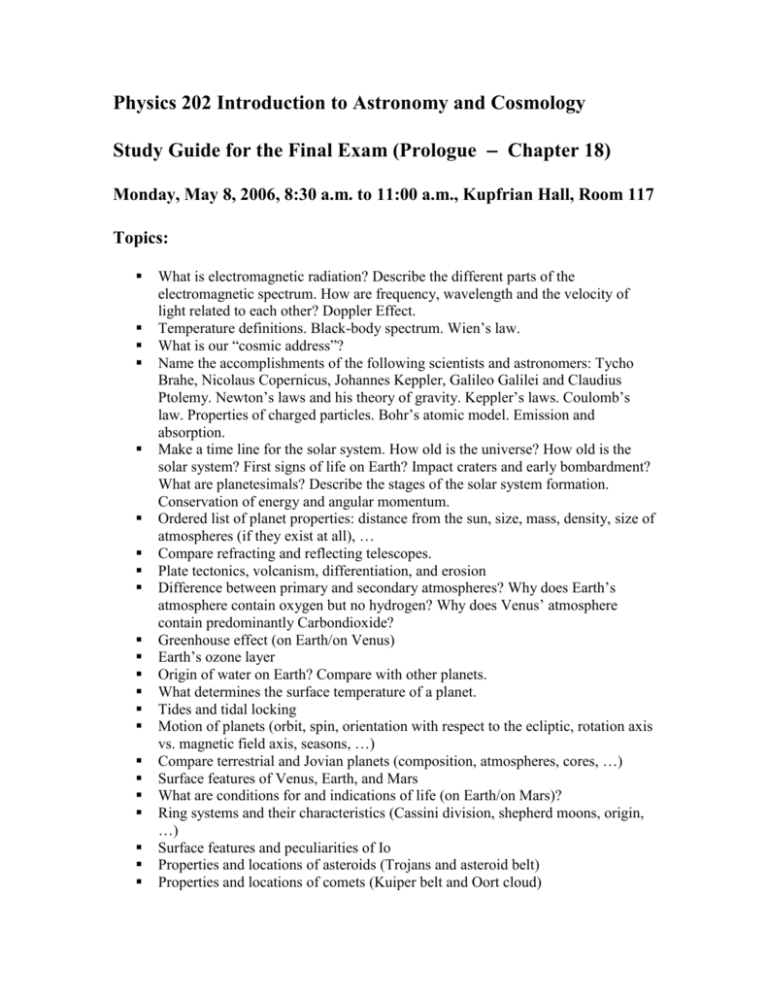
Physics 202 Introduction to Astronomy and Cosmology Study Guide for the Final Exam (Prologue Chapter 18) Monday, May 8, 2006, 8:30 a.m. to 11:00 a.m., Kupfrian Hall, Room 117 Topics: What is electromagnetic radiation? Describe the different parts of the electromagnetic spectrum. How are frequency, wavelength and the velocity of light related to each other? Doppler Effect. Temperature definitions. Black-body spectrum. Wien’s law. What is our “cosmic address”? Name the accomplishments of the following scientists and astronomers: Tycho Brahe, Nicolaus Copernicus, Johannes Keppler, Galileo Galilei and Claudius Ptolemy. Newton’s laws and his theory of gravity. Keppler’s laws. Coulomb’s law. Properties of charged particles. Bohr’s atomic model. Emission and absorption. Make a time line for the solar system. How old is the universe? How old is the solar system? First signs of life on Earth? Impact craters and early bombardment? What are planetesimals? Describe the stages of the solar system formation. Conservation of energy and angular momentum. Ordered list of planet properties: distance from the sun, size, mass, density, size of atmospheres (if they exist at all), … Compare refracting and reflecting telescopes. Plate tectonics, volcanism, differentiation, and erosion Difference between primary and secondary atmospheres? Why does Earth’s atmosphere contain oxygen but no hydrogen? Why does Venus’ atmosphere contain predominantly Carbondioxide? Greenhouse effect (on Earth/on Venus) Earth’s ozone layer Origin of water on Earth? Compare with other planets. What determines the surface temperature of a planet. Tides and tidal locking Motion of planets (orbit, spin, orientation with respect to the ecliptic, rotation axis vs. magnetic field axis, seasons, …) Compare terrestrial and Jovian planets (composition, atmospheres, cores, …) Surface features of Venus, Earth, and Mars What are conditions for and indications of life (on Earth/on Mars)? Ring systems and their characteristics (Cassini division, shepherd moons, origin, …) Surface features and peculiarities of Io Properties and locations of asteroids (Trojans and asteroid belt) Properties and locations of comets (Kuiper belt and Oort cloud) Ion and dust tail of comets What is the difference between meteors, meteorides, and meteorites? Extinction of dinosaurs. Compare the six largest moons in the solar system (atmosphere, surface structures, and cores) Energy transport mechanisms (heat conduction, radiation, and convection) Oblateness of Jovian planets Origin of magnetic fields on terrestrial and Jovian planets? Properties of the Sun: surface and core temperature, size, mass, … How do these values to the planets in the solar system. Solar activity: sunspots, CMEs, flares, filaments, prominences, and active regions. Solar cycle. Energy transport: convection vs. radiation Cosmic distance ladder. Parallax. Cepheid variables. Luminosity-distance relationship. Gravitational equilibrium. Hertzsprung-Russel Diagram: axes annotation, theoretical vs. observational, white dwarfs, red giants, main-sequence, luminosity, apparent vs. absolute brightness, evolutionary tracks (low- vs. high-mass stars) Planetary vs. emission nebulae. Globular clusters. Open clusters. Associations. Spectral sequence of stars (O, B, …). Where does star formation take place? Neutron stars vs. white dwarfs. Typical masses and sizes. Forces? Supernovae. Neutrinos. Nucleosynthesis. Origin of heavy elements? Black holes. Quasars. Schwarzschild radius. Dark matter. Anti-matter. Properties of the Milky Way Galaxy: type, diameter, number of stars, mass, mass distribution, rotation, … Hubble’s law. Critical density of the universe. Inflation. Microwave background radiation. Big Bang! Grand Unification Theory: four fundamental forces? Special relativity and speed of light. Please be aware that the Study Guide lists the bare minimum to be successful in the Second Exam. It’s not complete and their might be questions that are not 100% covered in the Guide. If you only rely on the Guide, you’ll do at your own risk!!! Good luck!





